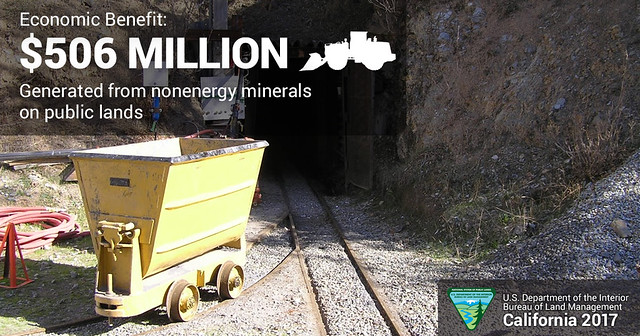California Mining and Minerals
Public lands in California provides opportunities for the exploration, development, and production of mineral resources, one of our most basic natural resources. With California's high population and large urban interface, mineral materials such as sand, gravel, and crushed stone are extracted from BLM administered public lands are used for ready-mixed concrete, asphalt, and many other building materials. Making locally available aggregate supplies available on public lands helps reduce consumer costs and environmental impacts.
The California gold rush of the 1800s continues today with small miners mining for gold and silver in more than 5,000 mining claims and where rockhounders search for rocks, minerals, and gemstones on public lands.
BLM collaborates with members of the public, representatives of private industry, local and state government agencies, and Native American tribes to carry out the mineral materials program on BLM administered lands in California.
- Laws
-
Mining Law of 1872
The federal law governing locatable minerals is the Mining Law of 1872 (May 10, 1872), which declared all valuable mineral deposits in land belonging to the United States to be free and open to exploration and purchase. This law provides citizens of the United States the opportunity to explore for, discover, and purchase certain valuable mineral deposits on federal lands that are open for mining location and patent (open to mineral entry).Mineral Leasing Act of 1920
This law provided for the leasing of minerals from public lands including oil, gas, coal and other non-energy leasable minerals such as phosphates and sodium. It requires that a royalty be paid on amounts mined and sold.Materials Act of 1947
This law provides for the disposal of mining materials on public lands, both saleable and leasable. Under this Act, some “common variety” minerals, such as sand and gravel, are subject to sale as opposed to rents and royalties.Mining and Mineral Policy of 1970
This law declares that it is the continuing policy of the federal government to foster and encourage private enterprise in the development of a stable domestic minerals industry and the orderly and economic development of domestic mineral resources. This act includes all minerals, including sand and gravel, geothermal, coal, and oil and gas.Stock Raising Homestead Act Amendment of April 16, 1993
Stock Raising Homestead Act (SRHA) lands are different from other federal lands in that the United States owns the mineral estate, but not the surface estate. Patents issued under the SRHA and Homestead Act entries patented under the SRHA reserve the mineral estate to the United States along with the right to enter, mine, and remove any reserved minerals that may be present in the mineral estate.Federal Land Policy & Management Act of 1976 (FLPMA)
This Act did not amend the 1872 law, but did affect the recordation and maintenance of claims. Persons holding existing claims were required to record their claims with the BLM, and all new claims and sites were required to be recorded with the BLM. The law gave the BLM information on the location and number of unpatented mining claims, mill sites, and tunnel sites; helped determine the names and addresses of current owners; and helped remove any cloud of title on abandoned claims. - BLM Regulations
-
The following is a list of commonly used mining-related entries in the Code of Federal Regulation (CFR):
43 CFR 1822.10 - How should my name appear on applications and other required documents that I submit to BLM?
Note: For documents and fees delivered in person, you or your representative may bring documents or payments to the proper BLM office by close of business on or before the due date. If the office is officially closed all day on the due date, payments may be brought in the next day the office is officially open.
43 CFR 3000.12 - What is the fee schedule for fixed fees?43 CFR 3710 - Public Law 167; Act of July 23, 1955
43 CFR 3730 - Public Law 359; Mining in Powersite Withdrawals; General
43 CFR 3740 - Public Law 585; Multiple Mineral Development
43 CFR 3800 - Mining Claims under the General Mining Laws (Includes 3809 Surface Management Regs)
43 CFR 3810 - Lands and Minerals Subject to Location
43 CFR 3820 - Areas Subject to Special Mining Laws
43 CFR 3830 - Locating, Recording, and Maintaining Mining Claims or Sites; General Provision
43 CFR 3832 - Locating Mining Claims or Sites
43 CFR 3833 - Recording Mining Claims and Sites
43 CFR 3834 - Required Fees for Mining Claims or Sites43 CFR 3835 - Waivers from Annual Maintenance Fees
43 CFR 3836 - Annual Assessment Work Requirements for Mining Claims
43 CFR 3837 - Acquiring a Delinquent Co-Claimant's Interest in a Mining Claim or a Site
43 CFR 3838 - Special Procedures for Locating and Recording Mining Claims and Tunnel Sites on Stockraising Homestead Act (SRHA) Lands
43 CFR 3860 – Mineral Patent Applications
43 CFR 3870 - Adverse Claims, Protests and Conflicts
- Cost Recovery
-
The BLM is authorized to charge cost recovery fees under the Federal Land Policy and Management Act of 1976 (FLPMA) and the 2005 Cost Recovery Rule. This year’s adjustment represents the ninth annual update to the fee schedule since the BLM first implemented a cost recovery fee schedule for certain oil and gas activities under the Cost Recovery Rule. The fee schedule is adjusted annually based on the change in the Implicit Price Deflator for Gross Domestic Product (IPD-GDP) from the 4th Quarter of one calendar year to the 4th Quarter of the following calendar year. The IPD-GDP is published annually by the Department of Commerce. Project proponents should discuss cost recovery with their BLM office.

